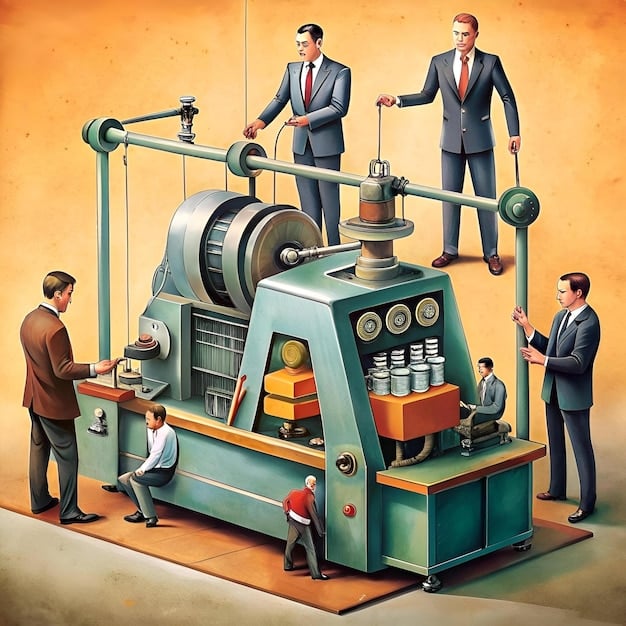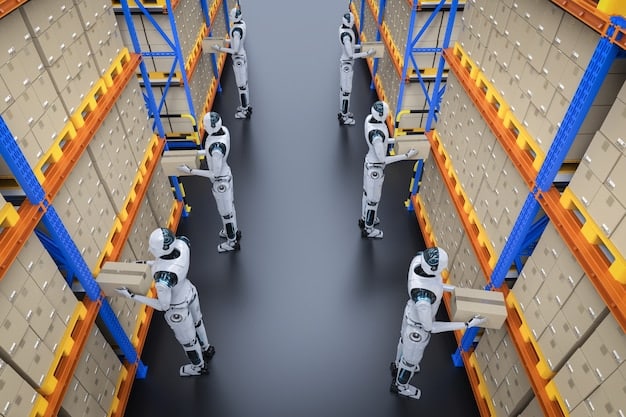Innovation and Technology: Driving US Economic Productivity

Innovation and technology play a pivotal role in boosting economic productivity in the US by fostering new industries, enhancing efficiency, and creating opportunities for growth and development.
The marriage of innovation and technology in driving economic productivity in the US is undeniable. These forces are not merely trends; they are the engine propelling the nation’s economy forward, shaping industries, and influencing the very fabric of how Americans work and live.
The Historical Impact of Innovation on US Productivity
Throughout history, the United States has been a hub of innovation, with each wave of technological advancement bringing about significant shifts in economic productivity. From the industrial revolution to the digital age, breakthroughs have consistently reshaped industries and propelled economic growth.
The First Industrial Revolution
The First Industrial Revolution, characterized by the advent of steam power and mechanization, dramatically altered the landscape of American productivity. The introduction of factories and mass production techniques led to unprecedented levels of output and efficiency.
The Digital Revolution
The Digital Revolution, marked by the rise of computers, the internet, and mobile technologies, has had an equally profound impact. Automation, data analytics, and e-commerce have transformed business operations and created entirely new industries.
These historical transformations underscore a clear pattern: innovation drives productivity, and productivity fuels economic growth. Understanding these patterns is crucial for navigating the challenges and opportunities of today’s rapidly evolving economic landscape.

Measuring Economic Productivity in the Age of Innovation
Economic productivity is typically measured as the ratio of output to input, reflecting the efficiency with which resources are utilized to produce goods and services. However, in the age of innovation, this measurement becomes more complex due to the intangible nature of many technological advancements.
Total Factor Productivity (TFP)
Total Factor Productivity (TFP) is a comprehensive measure that takes into account the contributions of labor, capital, and technological progress. It reflects the overall efficiency of resource utilization and the impact of innovation on economic output.
Challenges in Measuring Productivity
Measuring productivity in the digital age presents unique challenges. The value of many digital products and services is difficult to quantify, and traditional metrics may not fully capture the impact of innovations like artificial intelligence and machine learning.
- Accounting for the quality improvements driven by innovation.
- Capturing the value of free digital services.
- Addressing the time lags between innovation and measurable productivity gains.
Overcoming these challenges requires new approaches to measurement and a deeper understanding of the complex relationship between innovation and economic productivity.
Technology’s Role in Enhancing Productivity
Technology plays a multifaceted role in enhancing economic productivity. From streamlining operations to creating new markets, technological advancements provide businesses with powerful tools to optimize efficiency and drive growth.
Automation and Efficiency
Automation technologies, such as robotics and artificial intelligence, enable businesses to automate repetitive tasks, reduce labor costs, and improve accuracy. This leads to increased efficiency and higher levels of output.
Data Analytics and Decision-Making
Data analytics provides businesses with valuable insights into consumer behavior, market trends, and operational performance. By leveraging data-driven insights, companies can make more informed decisions, optimize resource allocation, and identify new opportunities for growth.

These examples highlight the transformative power of technology in enhancing economic productivity across various industries. As technology continues to evolve, its impact on productivity is only likely to increase.
The Role of Government and Policy in Fostering Innovation
Government and policy play a critical role in fostering innovation and driving economic productivity. By creating a supportive environment for research and development, incentivizing investment, and promoting education, government can help unlock the full potential of innovation.
Investment in R&D
Government investment in basic research and development is essential for creating the foundation upon which future innovations are built. Funding for research institutions, universities, and public-private partnerships can spur breakthroughs in science and technology.
Incentivizing Innovation
Tax incentives, grants, and other forms of financial support can encourage businesses to invest in innovation and develop new products and services. These incentives can help overcome the financial barriers that often hinder innovation.
Policies that promote competition, protect intellectual property, and encourage entrepreneurship are also crucial for fostering a vibrant innovation ecosystem. A well-designed regulatory framework can create a level playing field and incentivize businesses to pursue innovative solutions.
The Impact of Innovation on Different Sectors of the US Economy
The impact of innovation is not uniform across all sectors of the US economy. Some industries, such as technology and healthcare, are particularly reliant on innovation to drive growth and competitiveness, while others may benefit indirectly through increased efficiency and access to new technologies.
Technology Sector
The technology sector is at the forefront of innovation, with companies constantly developing new products, services, and business models. Innovations in software, hardware, and telecommunications have transformed how people live and work.
Healthcare Sector
The healthcare sector is also heavily reliant on innovation to improve patient outcomes, reduce costs, and develop new treatments for diseases. Innovations in medical devices, pharmaceuticals, and healthcare delivery are transforming the way healthcare is provided.
- Manufacturing: Automation and advanced materials are enhancing productivity and competitiveness.
- Agriculture: Precision farming and biotechnology are increasing yields and reducing environmental impact.
- Finance: Fintech innovations are transforming banking and financial services.
Understanding the specific impact of innovation on different sectors is essential for developing targeted policies and strategies to promote economic growth and competitiveness.
Future Trends in Innovation and Economic Productivity
As we look to the future, several key trends are likely to shape the relationship between innovation and economic productivity in the US. These include the rise of artificial intelligence, the increasing importance of sustainability, and the growing role of globalization.
Artificial Intelligence (AI)
Artificial intelligence has the potential to revolutionize industries and drive unprecedented levels of productivity. AI-powered systems can automate complex tasks, analyze vast amounts of data, and make intelligent decisions, freeing up human workers to focus on more creative and strategic endeavors.
Sustainability and Green Technologies
Sustainability is becoming an increasingly important driver of innovation, with companies developing new technologies and business models to reduce environmental impact and address climate change. Green technologies, such as renewable energy and energy-efficient building materials, are creating new opportunities for economic growth and job creation.
These trends highlight the dynamic and ever-evolving nature of innovation. By embracing these trends and investing in the technologies of the future, the US can maintain its competitive edge and drive sustainable economic growth.
| Key Point | Brief Description |
|---|---|
| 💡 Tech & Productivity | Tech advancements drive efficiency and growth. |
| 📈 Innovation Impact | Innovation is pivotal for economic productivity. |
| 🌱 Government Role | Policies boosting R&D essential for growth. |
| 🤖 Future Trends | AI and sustainability will shape productivity. |
Frequently Asked Questions (FAQ)
▼
Technology enhances productivity by automating tasks, improving data analysis, and creating new markets, leading to increased efficiency and growth.
▼
Innovation is crucial as it introduces new methods, products, and services, fostering competition and progress, ultimately boosting economic growth.
▼
Government support is vital for funding research and development, incentivizing private investment, and establishing policies that promote a competitive environment.
▼
Sectors like technology benefit directly through new advancements, while others, such as manufacturing, gain indirectly through automation and improved processes.
▼
Future trends include AI, sustainability, and globalization, which will likely redefine industries and enhance productivity in transformative ways.
Conclusion
In conclusion, the role of innovation and technology in driving economic productivity in the US is paramount. By fostering a culture of innovation, investing in research and development, and embracing new technologies, the US can ensure its continued economic prosperity and global competitiveness.






